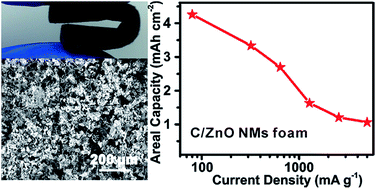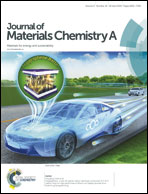Three-dimensional carbon/ZnO nanomembrane foam as an anode for lithium-ion battery with long-life and high areal capacity†
Abstract
Herein, an electrode architecture design using three-dimensional carbon/ZnO nanomembrane composite foam (C/ZnO NM foam) was proposed to achieve highly stable areal capacity at a practical mass loading. The composite, consisting of three-dimensional interconnected carbon foam anchored with two-dimensional ZnO NMs, was directly used as an anode of a lithium-ion battery without additional additives. The large surface area and high porosity of the carbon foam lead to a high ZnO loading of 3–4 mg cm−2. The flexibility of the ZnO NMs, effective electronic and ionic transport throughout the three-dimensional composite structure, and capacity from the carbon foam enhance the areal capacity and stability of the composite. Thus, the synthesized anode retains 92% capacity after 700 cycles at 2 A g−1 and after 500 cycles at 5 A g−1 and manifests a remarkable areal capacity of 4.3 mA h cm−2. The proposed approach and the composite structure produced in this study may have important potential applications in many fields requiring high energy storage capacity.



 Please wait while we load your content...
Please wait while we load your content...